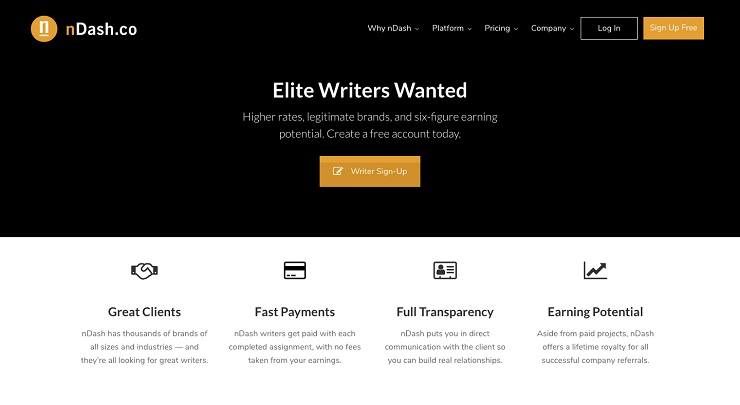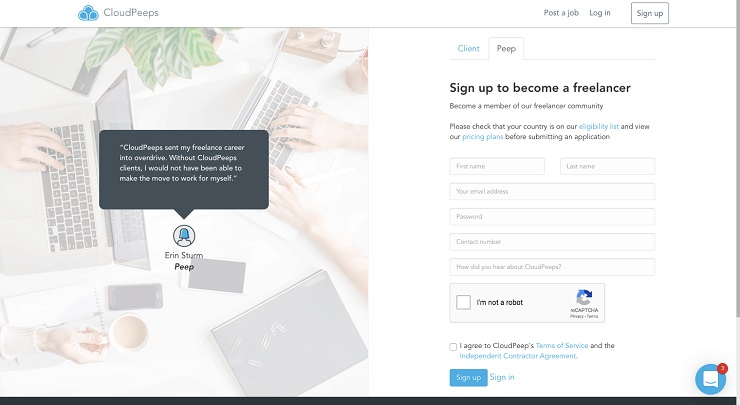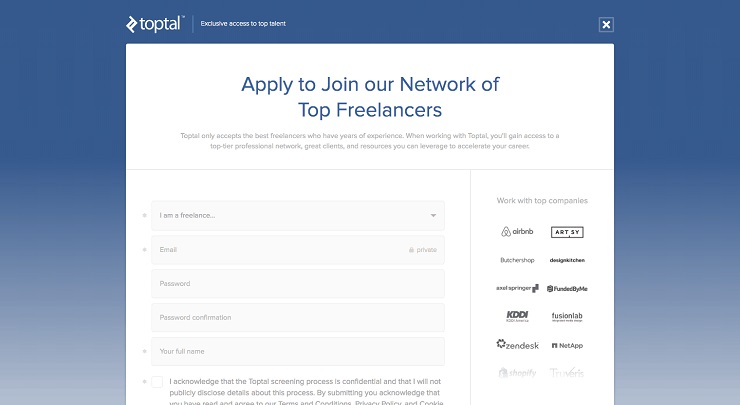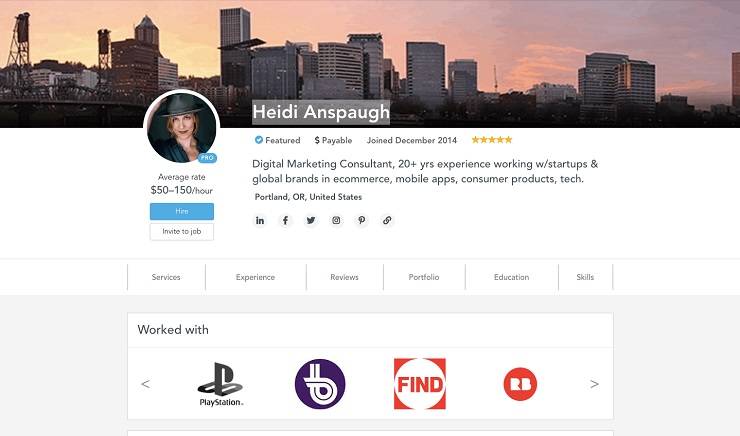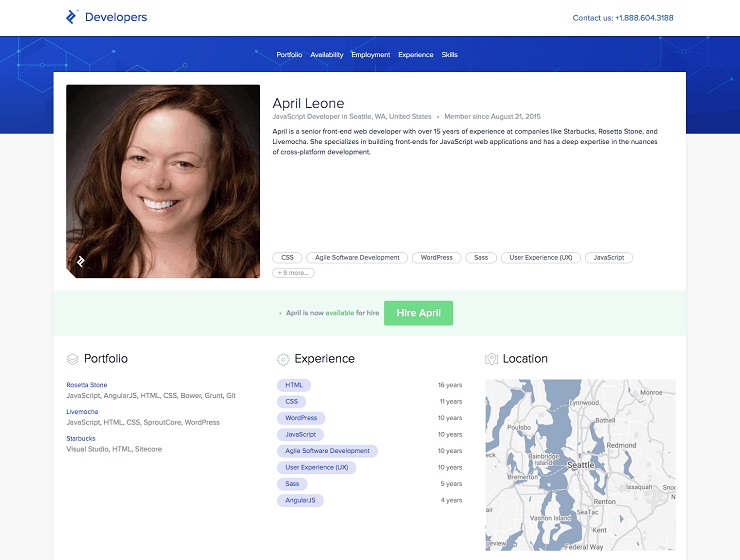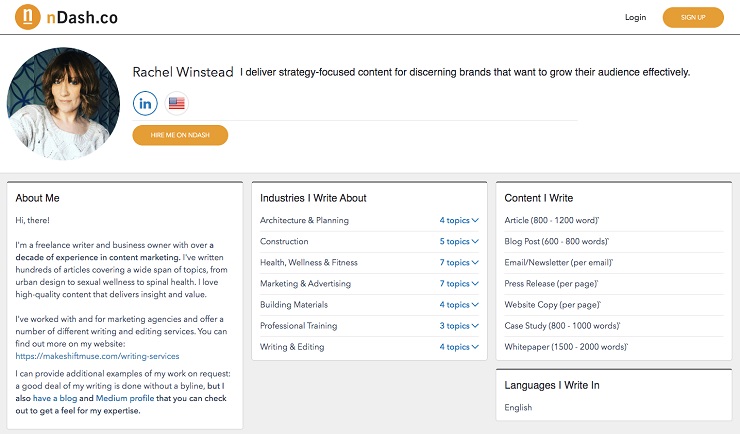Freelance marketplaces get a bad rap. While content mills and bidding sites often (deservedly) get berated for their rock-bottom rates and low-quality clientele, there are freelancing sites that feature high-quality gigs and offer competitive rates.
These can be great springboards from which to launch your freelance business—all from the comfort of your home (or wherever you have a laptop and wifi).
When I was a beginner freelancer, I used marketplaces like Skyword and CloudPeeps to build my portfolio and earn a decent income as I grew my business. Now, I’m no longer reliant upon them, but it’s nice to know I can always revisit their job boards if I need to. Plus, my experience working for clients on those platforms helped shape me into the freelancer I am today.
If you want to learn how to become a freelancer online using freelance marketplaces, below, I’ll show you the steps you need to take.
EXCLUSIVE FREE TRAINING: Successful Founders Teach You How to Start and Grow an Online Business
Step 1: Identify How You Can Help Others
I almost labeled this section “identify your skills,” but I don’t think that’s the right mindset to have when you approach becoming a freelancer. Like any business owner, your focus should be on how you can help your customers. You may have skills, but those skills may not be marketable. Or even if they are, you might not be able to market yourself effectively if you’re not thinking about how those skills help ease someone else’s pain.
Here are some ideas to help you figure out which freelance services you might be able to sell:
- Think about your previous jobs. What sorts of tasks did you do on a daily basis? Which projects were you assigned to? What did your coworkers ask you for help on? The answers to these questions will point you to the skills you have that other people need.
- Ask friends, family, and coworkers. Sometimes we have a hard time figuring out what we’re good at. To get an outside perspective, reach out to your network and ask them what your strengths are. You might be surprised by what other people notice about you.
- Review old messages. Comb through your old LinkedIn messages, texts, and emails; you might uncover a pattern of similar questions that people have asked you, which will help indicate where your expertise lies.
- Research the latest in-demand skills. Even if you don’t currently have those skills, it might be worth it to learn them and start selling them as a freelancer.
Step 2: Create a Simple Business Plan
Once you know which freelance services you want to sell, it’s time to write a simple business plan. The operative word here is “simple.” Don’t get bogged down trying to create a 40-page business plan when one page will do the trick. The goal is to have some semblance of a map to get to where you want to go.
The basics of your simple freelance business plan:
- What is your business? Summarize what your business does in two to three sentences.
- Why does your freelance business exist? Describe the mission or purpose of your freelance business.
- What does it sell? List the services you’ll offer.
- Who is your target audience? Describe what type of clients you’ll serve; be as specific as possible.
- How will you sell your services? Outline how you’ll find clients.
Armed with a business plan, you’ll be able to figure out the next steps and identify when a client is a good fit for you.
Step 3: Find the Right Freelance Marketplace for You
Now that you know where you’d like to go with your business, it’s time to explore your options when it comes to freelance marketplaces. When you’re just starting out, a freelance marketplace is helpful because it serves as a hub where you can create a portfolio, find jobs, submit proposals, and even invoice your clients.
Below, I’ll go over some popular freelance marketplaces that have shown themselves to be more specialized and high-quality, including two I’ve used myself.
nDash
Launched in 2014, this Boston-area startup boasts a community of more than 10,000 freelance writers and an impressive client list that includes LinkedIn, HubSpot, and Hitachi. Joining nDash as a writer is free, and it promises fast payment with no fees taken from your earnings. How much can you earn? It depends. nDash says that in its first year, two writers earned more than six figures.
nDash allows freelancers to set their own rates for assignments and puts them in direct contact with clients. There are three ways to win gigs on nDash: brands can contact you with a request; you can pitch ideas to brands; or you can apply for one of the assignments on the platform.
CloudPeeps
CloudPeeps connects brands with freelancers in many fields, from web design to writing to social media management. Some of the brands Peeps have worked for? Airbnb, Zappos, Lyft, and Indiegogo.
I joined CloudPeeps back in 2015 when the company had just launched, and within my first month, I landed two jobs. CloudPeeps has a job board that lists gigs from clients that typically pay a minimum of about $35/hour, though they can opt for a flat project fee as well. To date, I’ve earned well over $35,000 from this platform alone.
To become a freelancer on CloudPeeps, you must register for an account and then submit your profile for review. It should take around one week for it to be processed. Joining CloudPeeps is free, but to access the job board, you have to upgrade to the Standard plan at $9/month.
Freelancers on CloudPeeps can set their rates on their profiles, but to get an idea of what you might earn, the CP website does offer some ranges of typical rates offered by Peeps.
CloudPeeps sends weekly emails alerting freelancers of the latest job postings, but I recommend visiting the job board multiple times throughout the week to see the new listings before they are sent out.
Skyword
Skyword has established itself as a quality freelance marketplace for writers, photographers, videographers, and designers. According to its website, more than $30 million has been paid out to Skyword freelancers who have produced content for brands like Revlon, Colgate, and IBM.
I started writing for Skyword in 2014. When I wrote for the platform, I had no direct communication with the clients. When new assignments in my program became available, the program manager would send a mass email to the pool of writers I was in, asking us to claim them. It was first come, first served, so I was often rushing to snag assignments before they all disappeared. The pay was good for a relatively new freelance writer, though, at $85 to $250 per article.
To join Skyword as a freelancer, fill out this application.
Toptal
If you’re looking for a freelance marketplace for developers, designers, project managers, and the like, consider Toptal. Its client list includes Airbnb, Zendesk, Shopify, and Gucci. Toptal positions itself as having the “top 3% of freelance talent,” with a “very rigorous” freelancer screening process.
“Of the thousands of applications Toptal sees each month,” its website reads, ”typically fewer than 3% are accepted.” If you want to try your hand at it, you can apply to join Toptal as a freelancer.
Because its freelancer pool is top-tier, its rates typically are too. On Toptal’s FAQ page, you can find these suggested rates:
Developer:
- Hourly: $60-$95+/hour
- Part-time: $1,000-$1,600+/week
- Full-time: $2,000-$3,200+/week
Designer:
- Hourly: $70-$150+/hour
- Part-time: $1,200-$2,600+/week
- Full-time: $2,400-$5,200+/week
Finance:
- Hourly: $125-$200+/hour
- Part-time: $2,000-$3,200+/week
- Full-time: $4,000-$6,400+/week
Project Manager:
- Hourly: $80-$150+/hour
- Part-time: $1,300-$2,600+/week
- Full-time: $2,600-$5,200+/week
Product Manager:
- Hourly: $90-$180+/hour
- Part-time: $1500-$2800+/week
- Full-time: $3000-$5600+/week
Contently
Contently is a content marketing platform that powers big brands such as Google, Marriott, and Dell. Its freelance talent pool is among the best in the industry, and writers often talk about how good the pay is—if you can get noticed, that is.
Unlike the other platforms mentioned in this list, instead of a job board, Contently’s team actively scouts out new talent, so you must create a Contently portfolio that stands out. If your portfolio is deemed a good fit for one of its clients, someone from Contently will contact you.
According to its help center, “Contently pays its contributors the highest rates in the industry, and we expect the highest quality work in return.” Below is the table Contently uses to help clients decide what to pay writers:
Article (300–500 words) $255–$383
Article+ (500–700 words) $435–$683
Reported Article (400–700 words) $383–$574
Reported Article+ (700–1,000 words) $595–$893
Multi Source Article (700 – 1,000 words) $808–$1,148
Multi Source Article+ (1,000+ words) $935–$1,403
White Paper (1,000 – 2,000+ words):
–$1.00/word for Vertical 1: Lifestyle, Sports, Entertainment, Culture, Travel, Fashion
–$1.50/word for Vertical 2: Science, Consumer Tech, Healthcare, Consumer Finance
–$2.00/word for Vertical 3: B2B, Finance, Enterprise Tech, Law, Insurance
Of course, these are just a few of the freelance marketplaces out there. To find more that exist within your specific industry, do a Google search. Just be sure to read reviews about each platform, and ask around in your freelancer groups to see if anyone has had personal experiences with them.
For most freelancing sites, you can create a profile that clients can then peruse and decide if they want to work with you. Because of this, I recommend creating profiles on more than one site to increase your chances of getting found.
EXCLUSIVE FREE TRAINING: Successful Founders Teach You How to Start and Grow an Online Business
Step 4: Build an Appealing Profile
As you learned in the previous step, potential clients will be reviewing your profile on whichever freelance marketplace you choose, so it’s essential that you create one that makes them want to work with you.
Your Freelancer Bio
The bio on your freelance marketplace profile should instantly tell the reader about your relevant experience and your specialty. A simple (yet effective!) format is “I help .” So a business consultant might say, “I’ve been a business consultant for seven years and have worked with Fortune 500 companies. I now help women entrepreneurs create top-selling online courses.”
For freelance writers, a good bio will mention which niches you write about and which publications you’ve written for.
Lastly, your bio should end with a call to action, such as, “Email me for your free consultation” or “Check out my portfolio to learn more.”
The Work You Choose to Showcase
When it comes to making your freelance portfolio, no matter which freelance marketplace you use, it is crucial that you include your best work and only in the fields that you want to work in again. If your portfolio pieces span too many different niches, you might confuse potential clients who are looking for specialists. If your portfolio showcases your expertise in a niche you no longer want to work in, you might end up getting a gig that you don’t enjoy.
Professional-Looking Headshots
You don’t need to hire a professional photographer to get a headshot worthy of posting on your freelance marketplace profile. Just make sure the lighting is good (natural sunlight is always best), you’re not wearing anything too distracting (like crazy prints), and your face is in focus. I’ve never paid to have professional headshots taken for my freelancer profiles, and it’s never held me back.
Examples of Excellent Freelance Marketplace Profiles
I wanted to show you some outstanding profiles from some of the freelance marketplaces mentioned above. In all of the examples below, notice how their headshots are clear and professional, their bios tell you about their experience and their specialties, and their portfolios show their relevant pieces of work.
Evan MacDonald, Graphic Designer on Contently
Heidi Anspaugh, Digital Marketing Consultant on CloudPeeps
April Leone, Senior Front-End Web Developer on Toptal
Rachel Winstead, Freelance Writer on nDash
Step 4: Write Knockout Pitches/Proposals
Depending on the freelance marketplace, you’ll either have to submit proposals for gigs you are interested in or clients on the platform will reach out to you if they’re interested in your portfolio. Sometimes, both of these options are available.
For any freelancer, learning how to pitch is a crucial skill, and in freelance marketplaces where the competition can be stiff, it’s even more important.
- Read the job description carefully.
I know it’s easy to get eager and rush to submit a proposal for a gig you see on a freelance marketplace, but you need to read the description carefully before you start crafting your pitch. Often, a client gets multiple proposals, so one way to stand out is to be one of the few who actually reads the description and ensures it’s a good fit before reaching out.
- Follow the instructions.
This goes along with the previous tip: After you read the job description, make sure to follow the instructions. For instance, if they ask you for three examples of your best writing, don’t send them four. Not following the instructions can make you an automatic “no.” - Get creative. Just because you need to follow the instructions doesn’t mean you can’t think outside of the box too. Being creative in how you craft a proposal can do wonders for your acceptance rate. For example, I once submitted a proposal to a client who needed help improving her blog. I decided to record a screen-capture video showing me going through her current blog while talking about exactly what I’d fix. She was so impressed that she hired me! So when it comes to proposals, think about adding a little personal touch to make yours unique.
- End with a call to action. Just as in copywriting, your freelance proposals need to end with a call to action. What is it that you want the reader to do? A good formula for closing your proposals is + + . So, for example, “My three years working as a TV news reporter make me well-equipped to pitch daily story ideas and meet deadlines for your startup’s blog. When’s a good time to hop on a call to discuss more?”
- Follow up. If you don’t hear back within a couple of days, don’t give up! Send a followup message reiterating your enthusiasm for the job and what your ideas are for solving the client’s problem.
Step 5: Do Excellent Work
This should go without saying, but once you land a gig on a freelance marketplace, the real work begins!
Keep on top of deadlines, and always underpromise and overdeliver. After completing a gig, if the platform has a rating system, be sure to ask your client to review you. These reviews can boost your profile’s ranking in that particular freelance marketplace and make people more inclined to work with you. As you win more gigs, it creates a snowball effect that helps you gain more clients quickly.
Also, after the successful completion of a project, ask your client to refer you to other potential clients if they were happy with your work. This is how you start growing a steady client base.
Step 6: Keep Your Profile Up to Date
Because freelance marketplaces rely so heavily on your profile’s content to match you with clients, you must keep it up-to-date. As you complete more gigs, be sure to add your best pieces to your portfolio—and remove any outdated, subpar ones—to keep it fresh. You also need to update your skills as you gain new ones. Many freelance marketplaces allow you to tag your profile with relevant skills (video editing, copywriting, project management, etc.), and this is the only way they can match you with suitable opportunities.
Step 7: Branch Out and Become Independent from Freelance Marketplaces
While freelance marketplaces are great places to start your freelance career, the ultimate goal is to wean yourself off of them. Because these marketplaces often take a commission out of your earnings, it’s best to be able to eventually gain clients directly through your own website and marketing.
Freelance marketplaces are hubs that make it easy to find clients and build your portfolio. After you’ve completed a few projects on these platforms, you can use those pieces to showcase your talent on your own website. Eventually, you’ll find new clients through word-of-mouth too and won’t need to do as much pitching.
Becoming independent and finding your own clients is the most sustainable model for your freelance business, but that doesn’t mean you have to abandon freelance marketplaces altogether. They can continue to be a great source of supplementary income.
Are Freelance Marketplaces Your Stepping Stone to a Flourishing Freelance Business?
If you’re just starting your freelance career, get a helping hand by joining freelance marketplaces that can connect you with quality clients at competitive rates.
Here are the steps we went over:
- Step 1: Identify how you can help others
- Step 2: Create a simple business plan
- Step 3: Find the right freelance marketplace(s) for you
- Step 4: Write knockout pitches and proposals
- Step 5: Do excellent work
- Step 6: Keep your profile up to date
- Step 7: Branch out and become independent of freelance marketplaces
Remember, freelance marketplaces are just a stepping stone. When you’re ready to level up and win clients on your own, we’ve got a complete guide on how to become a freelancer.
EXCLUSIVE FREE TRAINING: Successful Founders Teach You How to Start and Grow an Online Business
Have you found clients through freelance marketplaces? Share your experiences with us in the comments below!


